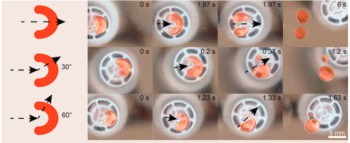Researchers have been able to propel tiny polystyrene balls in a hydrogen-peroxide solution by coating them on one side with platinum. The micrometre-sized balls move because the platinum converts hydrogen peroxide into water and oxygen -- causing water to flow towards one side of the ball. The researchers believe that these "artificial swimmers", which move nearly as fast as swimming bacteria, could be someday be adapted to deliver drugs within the body (Phys. Rev. Lett. to be published).

Making micrometre-sized objects swim is no easy task because over very short distances, water behaves like a very viscous fluid such as honey. Some bacteria manage to swim by using highly specialized undulating whips called flagella – and while some progress has been made in creating artificial flagella, they have proved very difficult to mimic in a tiny machine.
In 2005 Ramin Golestanian, a theoretical physicist at the University of Sheffield in the UK and colleagues proposed a much simpler way of propelling tiny objects that uses no moving parts. Now a team led by fellow Sheffield physicist Richard Jones has created such a propulsion system for making particles swim in a solution of water and hydrogen peroxide.
The team used polystyrene balls that were about 1.6µm in diameter and had one side coated with platinum — a catalyst that boosts the rate at which hydrogen peroxide is converted into oxygen and water. This reaction decreases the concentration of hydrogen peroxide in the region near the platinum-coated side of the sphere, causing water to flow away from the region in order to maintain equilibrium. This flowing water pushes the object in a specific direction relative to the coating– if the platinum is on the right hand side of the sphere, for example, the sphere would move to the left.
By looking at the system with an optical microscope, the researchers saw that the balls could reach speeds of 5µm/s — which is not far off the 10µm/s observed in similarly-sized bacteria. According to Golestanian, the propulsion technique could be adapted to work in other liquids including blood, which could someday allow micromachines to swim within the body to deliver drugs to specific locations.
However like bacteria, the swimmers also have to contend with another consequence of being very small –- being knocked off course by random collisions with water molecules in a process called Brownian motion. Indeed, after a few seconds of motion in a specific direction, the Sheffield swimmers followed completely random paths.
Golestanian told physicsworld.com that thermodynamics makes it impossible to design a tiny object that would be able to avoid Brownian motion on its own and travel in a straight line. Instead, he believes that the objects could be guided externally – for example, if a magnetic dipole could be placed in the object, it could be steered using a magnetic field.



